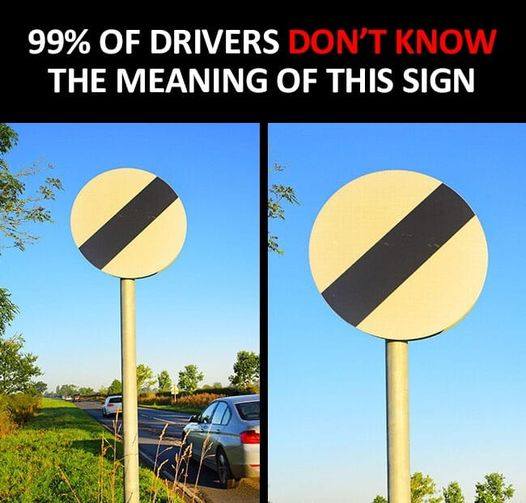The Importance of Understanding Road Signs: A Closer Look at the National Speed Limit
A recent social media discussion erupted in the UK after a driver asserted that a staggering “99% of motorists” fail to grasp the significance of a particular road sign frequently encountered across the nation. This sign, characterized by a circular white disc marked with a thick black diagonal stripe, is designed to convey pivotal information about speed regulations. Unfortunately, despite its inclusion in essential driving theory examinations, many drivers tend to forget its implications soon after passing their tests, leading to significant confusion on the roads.
Officially recognized, the sign denotes the national speed limit, which varies based on the type of roadway and the kind of vehicle being driven. For standard passenger vehicles operating on single carriageways, the legal speed limit is set at 60 mph. In contrast, drivers on dual carriageways and motorways can legally accelerate to a maximum of 70 mph. However, it is crucial to note that vehicles towing trailers or larger vans face stricter regulations, with limits of 50 mph on single carriageways and 60 mph on dual carriageways and motorways. In urban areas equipped with street lighting, the default speed limit reverts to 30 mph to enhance safety in densely populated regions.
Despite the clarity of these regulations, the national speed limit sign has become the subject of light-hearted jokes and speculation online. Some drivers humorously interpret the sign as an invitation to “drive as fast as you want,” while others have whimsically labeled it a “national drifting zone.” Such misinterpretations can lead to reckless behavior on the roads, including speeding and irresponsible overtaking. This highlights a crucial issue: many motorists are misreading the sign as a green light to exceed safe speeds, disregarding surrounding conditions such as traffic density, weather, and road quality.
Road safety experts have voiced their concerns regarding the widespread misunderstanding of the national speed limit, emphasizing that it represents the upper limit rather than a recommended speed. The Royal Automobile Club (RAC) and various other organizations stress that responsible driving must always take precedence, irrespective of what the signage indicates. The reality on the roads is often more complex than simply adhering to a posted speed limit; various factors call for drivers to adjust their speed accordingly, ensuring the safety of themselves and other road users.
This pervasive confusion surrounding the national speed limit sign serves to underline a significant gap between theoretical knowledge and practical driving application. Even seasoned drivers can falter in their understanding of the rules, particularly when faced with the pressures of real-world driving scenarios. Therefore, refreshing one’s knowledge of road signs and regulations is not only advisable but necessary for fostering safer driving practices. Engaging in continual learning about road safety can significantly mitigate the risks associated with driving. For instance, many driving schools now recommend periodic refresher courses, especially for drivers who may have been on the road for decades.
Moreover, it is essential to recognize that speed limits are not arbitrary numbers; they are the product of extensive research and are designed to enhance safety. For example, speed limits take into account factors such as accident statistics, road conditions, and the presence of vulnerable road users like children and the elderly. In areas with a high density of pedestrians, lower speed limits play a crucial role in reducing the severity of accidents. Therefore, understanding the rationale behind speed limits can significantly impact how drivers approach their responsibilities on the road.
Furthermore, enforcement of speed limits is another crucial aspect of road safety. Authorities employ various methods, such as speed cameras and police patrols, to ensure compliance. However, the effectiveness of these measures is often dependent on drivers’ understanding and acceptance of speed limits. When drivers view speed limits as mere suggestions rather than legal requirements, the likelihood of speeding increases, contributing to a higher incidence of road traffic accidents. Hence, public education campaigns aim to reinforce the importance of speed limit adherence and the potential consequences of violations.
Ultimately, the national speed limit sign transcends its role as mere regulatory signage; it serves as a critical reminder of the necessity of speed limits. These limits are established for a reason—primarily to protect all road users, including pedestrians, cyclists, and other drivers. Observing speed limits, maintaining heightened awareness, and driving cautiously are vital components of responsible driving. A collective commitment to adhering to speed regulations can contribute significantly to enhancing road safety and reducing the number of accidents. In conclusion, understanding road signs, particularly the national speed limit indicator, is essential for fostering a culture of safety and responsibility on the roads.
In summary, addressing the misconceptions surrounding the national speed limit sign is imperative for promoting safe driving behaviors. Continuous education, active engagement with driving regulations, and adherence to speed limits can significantly diminish risks on the road. By fostering an environment where drivers are well-informed and aware of their responsibilities, we can work towards safer roadways for everyone. It is not just about obeying the law but about fostering a community of conscientious drivers who prioritize safety above all else.

















